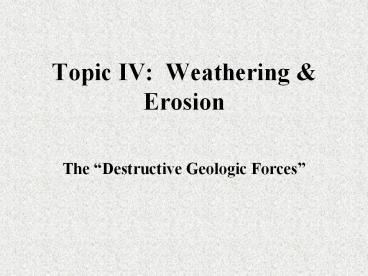Topic IV: Weathering - PowerPoint PPT Presentation
1 / 16
Title:
Topic IV: Weathering
Description:
How is the Earth s surface shaped by weathering, erosion, and deposition ? ... be broken down by weathering so that it can be transported by the agents of erosion. – PowerPoint PPT presentation
Number of Views:131
Avg rating:3.0/5.0
Title: Topic IV: Weathering
1
Topic IV Weathering Erosion
- The Destructive Geologic Forces
2
When You Have Finished This Unit, You should be
able to answer the following questions...
- How is the Earths crust affected by its
environment ? - What are the products of weathering ?
- How are the products of weathering transported ?
- How are eroded materials deposited ?
- How is the Earths surface shaped by weathering,
erosion, and deposition ?
3
Definitions..
- Weathering - the slow continuous process by which
nature breaks down rock material into smaller
particles. The two major types of weathering are
mechanical chemical
- Erosion - the breakdown and transport of
weathered material by the agents of erosion -
running water, wave and current action, glaciers,
wind, and gravity.
4
Mechanical Weathering
- The breakdown of rock material into smaller
particles of the same material. - Example - Granite bedrock breaks down into
smaller particles of granite
5
Agents of Mechanical (aka Physical) weathering
include...
- Ice wedging
- Frost action
- Unloading
- Plant Action
- Animal Action
6
Ice Wedging
- As water seeps into the pre-existing cracks in
rocks, it may freeze. - As the water freezes, it expands.
- The expanding freezing water wedges the crack in
the rock further open.
7
Frost Action
- As rock material is heated, it expands.
- The exterior of the rock may be heated while the
interior is still cold and contracted from the
cold night temps. - This pulls the outer layer of rock away in a
process called exfoliation.
8
Unloading
- When rock which has been buried by other
sediment, rock, or ice is exposed, it may expand
under the released pressure. - This expansion causes the outer layers of rock to
exfoliate
9
Animal Action
- As animals burrow into rock and soil, they break
the material down into smaller particles of the
same material. - Examples include worms, ground hogs, chipmunks,
etc.
10
Plant Action
- The roots of growing plants will grow into
existing cracks of rock and enlarge the openings. - Smaller plants (lichens, e.g.) dig their tiny
roots into small cracks with the same result.
11
Chemical Weathering...
- involves the breakdown of rock material into new
material with a new chemical make-up. In other
words, the rock has turned into new rock
material. (decomposition) - Agents of chemical weathering include oxidation,
carbonation, hydration, and dissolution.
12
Oxidation
- Oxidation is the chemical union of oxygen with a
molecule within the rock. Rust is a common
form of oxidation and is seen on many iron rich
rocks around the ONeill campus.
13
Carbonation
- As water falls through the atmosphere, a mild
acid forms which can dissolve away limestone to
form caves.
14
Hydration
- The chemical union of water molecules with
mineral molecules is known as hydration. - Iron and magnesium minerals will alter to clay
minerals due to hydration. Feldspar also
hydrates to form clay minerals.
15
Dissolution...
- Certain minerals will actually dissolve when
exposed to water or mild acids. The sample shown
here is halite, a highly soluble mineral more
commonly known as rock salt
16
In order for erosion to occur...
- Material must first be broken down by weathering
so that it can be transported by the agents of
erosion. - Remember that chemical weathering can only occur
on exposed surfaces.































